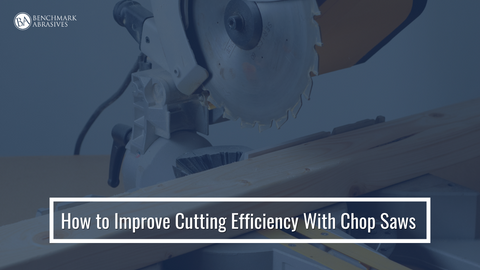
How to Improve Cutting Efficiency With Chop Saws

Efficiency, adaptability, and dependability are crucial in metalworking. This white paper examines the numerous benefits of cutting metal with an abrasive chop saw, sometimes called an abrasive cutoff saw. The chop saw is one of the most valuable tools in fabricators' and welders' operations. Chop saws allow users to make repeated cuts precisely and safely. A chop saw is perfect for cutting bits of threaded rod, angle brackets, struts, or steel studs as long as the user uses the best wheel. Let's talk about further chop saws:
A CHOP SAW - WHAT IS IT?
This indispensable electronic tool enables the user to chop using the wheel's circumference precisely. The saw has a back fence that, in many circumstances, may be rotated to create 45-degree miter cuts.
Because they are movable, chop saws can be moved from one location to another as needed. Because of their adaptability, fine chop saws are often utilized on a tabletop or bottom; this makes them popular among welding shops, mechanical contractors, and maintenance businesses. It is essential to understand chop saws to get the most out of their use.
CONSIDERATIONS FOR USING A CHOP SAW
Here are a few valuable pointers for using a chop saw efficiently;
- When cutting the cloth, turn the wheel to the right.
- The saw must be disconnected from the power supply in order to install a replacement blade, and the wheel surface must be positioned between the flanges and the appropriate paper mounting blotters (most toolmakers sell these blotters).
- To maximize cutting efficiency and life, position the middle of the fabric to be cut just beneath the arbor's center on the saw before beginning any cuts.
DIRECTIONS FOR USING A CHOP SAW
The facility equipment is used to cut materials like metal, tiles, concrete, etc. It is called a chop saw wheel. It's also known as an abrasive saw and stop wheel. Usually, the machine has a thin buzz saw blade to provide a genuine quality cut and prolong the life of your stop wheel.
A DETAIL ABLE COMPREHENSION OF THE SYSTEM
It would help if you thought about the chop saw's application before using it.
- What kind of material will you be cutting?
- What dimensions would it have?
- What type of cut and finish is desired?
These are a few things to think about before using a tool for any activity. Numerous chop saws for the metal have varied uses. Thus, it would help if you got to work after taking note of these factors.
BENEFITS OF CHOP SAW
1. REDEFINING ADAPTABILITY
The unparalleled adaptability of an abrasive chop saw is its distinguishing feature. It can cut through a wide range of steel types, including solid and light alloys. Because of its intrinsic adaptability, metalworkers may handle a wide range of jobs with speed and dependability, as it eliminates the need for specialized cutting tools.
2. THE ART OF BLADE HARDNESS ALIGNMENT
Matching the hardness of the blade to the steel being cut is a crucial step in getting the best results possible from an abrasive chop saw. This idea, which may appear straightforward, is vital. When working with more rigid steel, it is best to use a softer edge and vice versa. The lifespan of your cutting blades is significantly increased, and this alignment ensures effective cutting.
3. OVERCOMING ALLOY DIFFICULTIES
Because of their remarkable hardness, alloys can be challenging to cut with many cutting tools. But in this field, abrasive cutoff saws are superior. Their unique abrasive cutoff wheels are designed to withstand alloy hardness, providing accurate, clean cuts on even the most difficult materials.
4. ADAPTABLE TO ALL METAL TYPES
Abrasive cutoff wheels are made to work with a wide range of metal types, including cold rolled steel, stainless steel, and high-strength materials like Inconel. Regardless of the material, this versatility provides consistent, high-quality results and streamlines your metalworking processes.
5. THE SCIENCE OF BLADE SELECTION
The key to optimizing your metal cutting is choosing the appropriate abrasive cutoff wheel. It is best to get advice from a reliable source of abrasive wheels in order to make an informed decision. They possess the knowledge and experience to help you choose the right wheel for your cutting needs, guaranteeing top performance.
6. SAFE CLAMPING: ESSENTIAL FOR BETTER FINISHES AND CUTS
Whether cutting dry or with a coolant, it's important to note that firmly holding your metal on both sides of the blade is essential to achieving a higher-quality cut and finish. This process reduces vibrations, improves stability, and yields cleaner, more accurate cuts; it also emphasizes how crucial good workpiece clamping is for metal cutting.
THE DOS AND DON'TS OF USING A CHOP SAW
When not used properly, chop saws can be difficult to wield. It would be beneficial if you kept an eye out for a few things when using these wheels. By following the advice in the dos and don'ts list, you may ensure that the tool is used safely and avoid breaking it.
DOS:
- Prior to use, always inspect the wheel to prevent any harm or damage.
- Make sure the wheel is always free of damage or cracks.
- Use chop saw wheels exclusively with chop saw equipment.
- Always use caution when handling and storing stop wheels.
DON'TS
- Make sure you don't apply pressure, twist, squeeze, or cramp on the wheel's side.
- Never take off the tool's guard, and always remember to use it.
- Avoid applying too much downward force to the wheels.
- Kindly refrain from using it on any machines that lack the appropriate wheel protectors.
- Avoid causing harm to the wheel's side.



































































